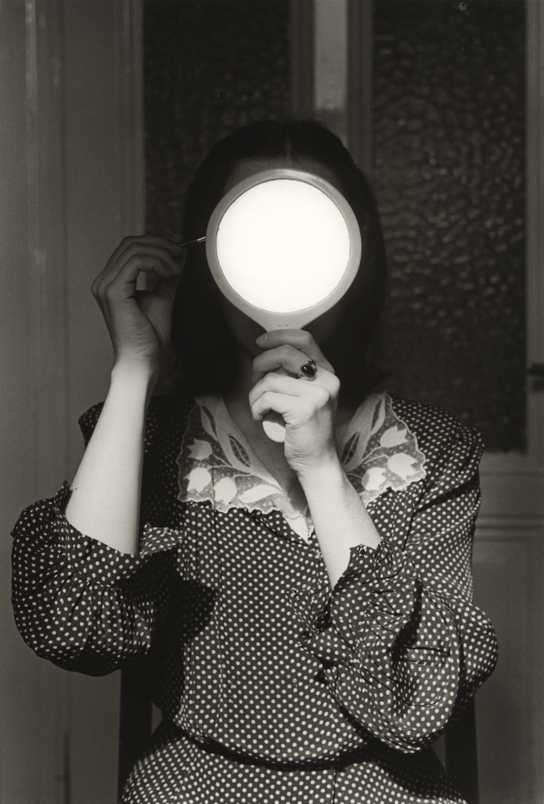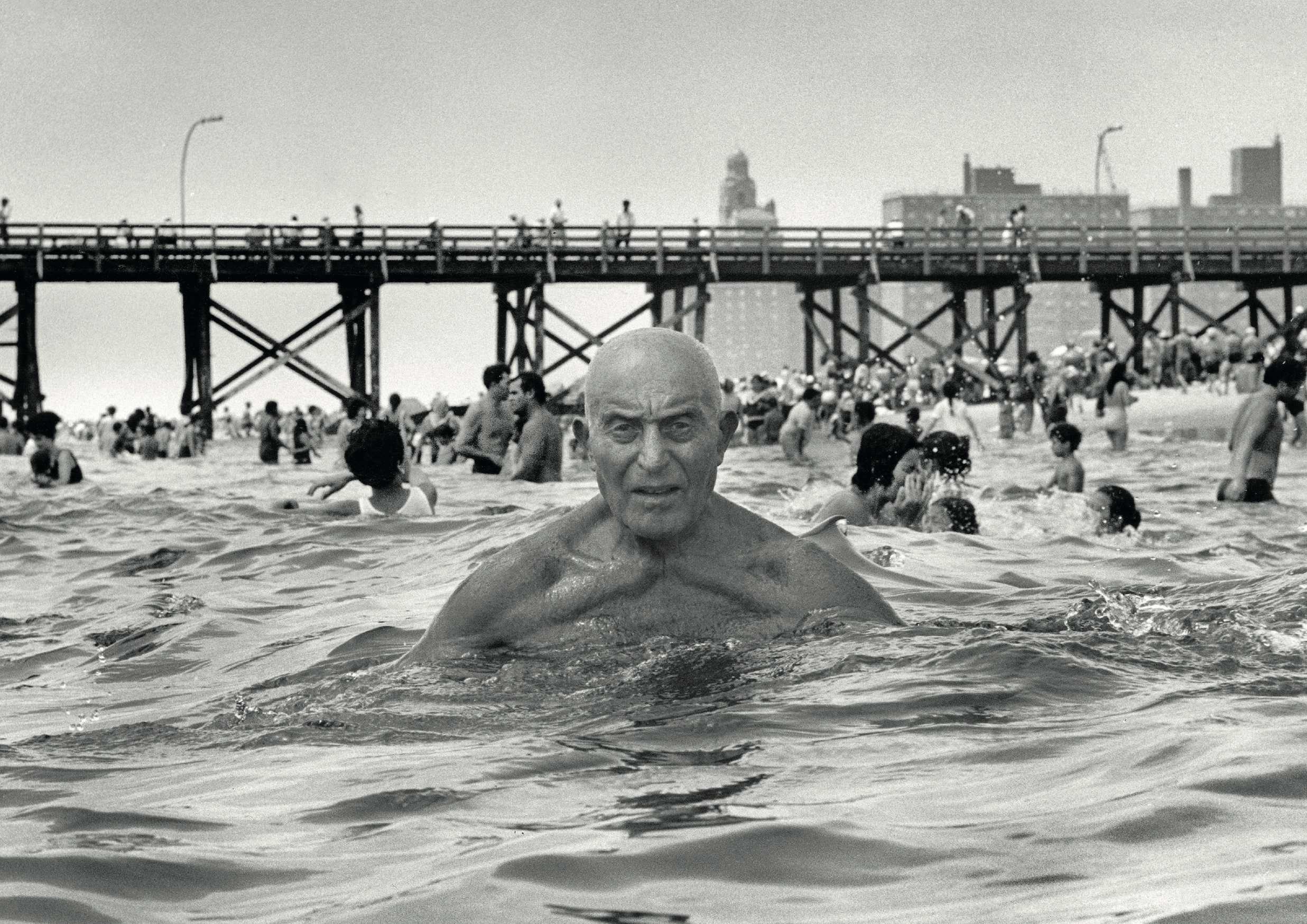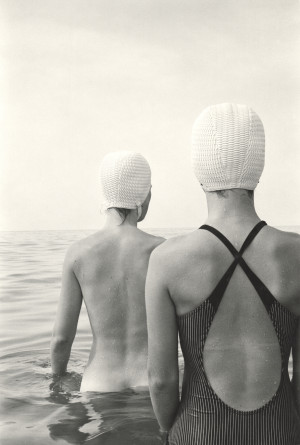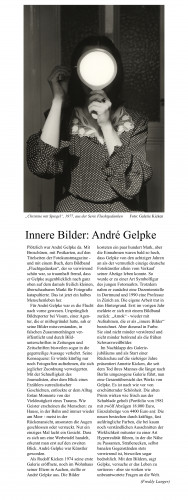ANDRÉ GELPKE
EXHIBITION Sep 19, 2015 — Jan 29, 2016






ANDRÉ GELPKE (*1947)
"Mann mit Brille", from the portfolio "Fluchtgedanken. Ein Monolog", 1978 / 1981
12 gelatin silver prints
ca. 28,5 x 18,9 cm (each )
© André Gelpke / Courtesy Kicken Berlin

ANDRÉ GELPKE (*1947)
"Christine mit Spiegel", from the portfolio "Fluchtgedanken. Ein Monolog", 1977 / 1981
12 gelatin silver prints
ca. 28,5 x 18,9 cm (each )
© André Gelpke / Courtesy Kicken Berlin

ANDRÉ GELPKE (*1947)
"San Francisco", from the portfolio "Fluchtgedanken. Ein Monolog", 1980 / 1981
12 gelatin silver prints
ca. 28,5 x 18,9 cm (each )
© André Gelpke / Courtesy Kicken Berlin

ANDRÉ GELPKE (*1947)
"Antibes", from the portfolio "Fluchtgedanken. Ein Monolog", 1979 / 1981
12 gelatin silver prints
ca. 28,5 x 18,9 cm (each )
© André Gelpke / Courtesy Kicken Berlin

ANDRÉ GELPKE (*1947)
"Sylt", from the portfolio "Fluchtgedanken. Ein Monolog", 1980 / 1981
12 gelatin silver prints
ca. 28,5 x 18,9 cm (each )
© André Gelpke / Courtesy Kicken Berlin

ANDRÉ GELPKE (*1947)
Rocker, 1970
gelatin silver print, printed 1970
32,5 x 21,9
© André Gelpke / Courtesy Kicken Berlin

ANDRÉ GELPKE (*1947)
Rocker, Hamburg, 1970
gelatin silver print, printed 1970
32,6 x 21,8 cm
© André Gelpke / Courtesy Kicken Berlin

ANDRÉ GELPKE (*1947)
Untitled (Swan Boat)‘, from the series 'Amok'", 1999
inkjet print on Hahnemühle Fine Art Baryta paper, printed 2015
42 x 27,5 cm
© André Gelpke / Courtesy Kicken Berlin

ANDRÉ GELPKE (*1947)
Frau mit Zigarette / Woman with Cigarette, 1977
gelatin silver print, printed 1977
40,9 x 27,4 cm
© André Gelpke / Courtesy Kicken Berlin

ANDRÉ GELPKE (*1947)
Kleiner Junge mit Revolver / Little Boy with Revolver, 1983
gelatin silver print, printed 1983
41 x 33,6 cm
© André Gelpke / Courtesy Kicken Berlin

ANDRÉ GELPKE (*1947)
Karneval, Düsseldorf / Carnival, Düsseldorf, 1983
gelatin silver print, printed 1983
40,9 x 33,9 cm
© André Gelpke / Courtesy Kicken Berlin

ANDRÉ GELPKE (*1947)
Kinderkarneval, Düsseldorf / Children's Carnival, Düsseldorf, 1982
gelatin silver print, printed 1982
41 x 33,5 cm
© André Gelpke / Courtesy Kicken Berlin

ANDRÉ GELPKE (*1947)
Coney Island, 1972
gelatin silver print, printed 1972
27,4 x 41,3 cm
© André Gelpke / Courtesy Kicken Berlin

ANDRÉ GELPKE (*1947)
'Marlies', Alcazar, from the Series 'Sex- Theater', 1978
gelatin silver print, printed ca. 1978
32,5 x 21,9 cm
© André Gelpke / Courtesy Kicken Berlin

ANDRÉ GELPKE (*1947)
Galerie Heike Curtze, from the series 'Vernissagen', 1980
gelatin silver print, printed 1980
20,4 x 32,7 cm
© André Gelpke / Courtesy Kicken Berlin

ANDRÉ GELPKE (*1947)
Schützenfest / Marksmen's Festival, 1979
gelatin silver print, printed 1979
21,9 x 32,7 cm
© André Gelpke / Courtesy Kicken Berlin

ANDRÉ GELPKE (*1947)
Gürzenich, Köln / Gürzenich, Cologne, 1978
gelatin silver print, printed 1978
22 x 32,7 cm
© André Gelpke / Courtesy Kicken Berlin

ANDRÉ GELPKE (*1947)
Gürzenich, Köln / Gürzenich, Cologne, 1978
gelatin silver print, printed 1978
22 x 32,7 cm
© André Gelpke / Courtesy Kicken Berlin

ANDRÉ GELPKE (*1947)
Museum Folkwang, from the series 'Vernissagen', 1980
gelatin silver print, printed 1980
20,4 x 32,6 cm
© André Gelpke / Courtesy Kicken Berlin

ANDRÉ GELPKE (*1947)
Untitled (Hand on Boy's Face)‘, from the series 'Amok', 2008
inkjet print on Hahnemühle Fine Art Baryta paper, printed 2015
35 x 26 cm
© André Gelpke / Courtesy Kicken Berlin

ANDRÉ GELPKE (*1947)
Untitled (Crushed Fender)‘, from the series 'Amok', 2010
inkjet print on Hahnemühle Fine Art Baryta paper, printed 2015
42 x 31,5 cm
© André Gelpke / Courtesy Kicken Berlin

ANDRÉ GELPKE (*1947)
Untitled (Artificial Flowers), from the series 'Amok', 2010
inkjet print on Hahnemühle Fine Art Baryta paper, printed 2015
42 x 31,5 cm
© André Gelpke / Courtesy Kicken Berlin

ANDRÉ GELPKE (*1947)
Untitled (Child's Hand with Traces of Felt Pen), from the series 'Amok', 2000
inkjet print on Hahnemühle Fine Art Baryta paper, printed 2015
35 x 23,2 cm
© André Gelpke / Courtesy Kicken Berlin

ANDRÉ GELPKE (*1947)
Untitled (Hats in Window), from the series 'Amok', 2008
inkjet print on Hahnemühle Fine Art Baryta paper, printed 2015
35 x 26 cm
© André Gelpke / Courtesy Kicken Berlin

ANDRÉ GELPKE (*1947)
Untitled (Torn Open Pavement), from the series 'Amok', 2013
inkjet print on Hahnemühle Fine Art Baryta paper, printed 2015
42 x 31,5 cm
© André Gelpke / Courtesy Kicken Berlin

ANDRÉ GELPKE (*1947)
'Rita', Salambo, from the Series 'Sex-Theater', 1976
gelatin silver print, printed ca. 1976
32,6 x 22 cm
© André Gelpke / Courtesy Kicken Berlin

ANDRÉ GELPKE (*1947)
Rita, Salambo, St. Pauli, from the Series 'Sex-Theater', 1976
gelatin silver print, printed ca. 1976
32,6 x 21,9 cm
© André Gelpke / Courtesy Kicken Berlin

ANDRÉ GELPKE (*1947)
Untitled (Geisha from Behind), from the series 'Amok', 2012
inkjet print on Hahnemühle Fine Art Baryta paper, printed 2015
42 x 31,5 cm
© André Gelpke / Courtesy Kicken Berlin

ANDRÉ GELPKE (*1947)
Untitled (Woman with Roses Hair Tie from Behind), from the series 'Amok', 2006
inkjet print on Hahnemühle Fine Art Baryta paper, printed 2015
42 x 28,1 cm
© André Gelpke / Courtesy Kicken Berlin

ANDRÉ GELPKE (*1947)
Untitled (Lady with Curles from Behind), from the series 'Amok', 2006
inkjet print on Hahnemühle Fine Art Baryta paper, printed 2015
35 x 26,2 cm
© André Gelpke / Courtesy Kicken Berlin

ANDRÉ GELPKE (*1947)
Untitled (Blonde from Behind), from the series 'Amok', 2008
inkjet print on Hahnemühle Fine Art Baryta paper, printed 2015
35 x 26,2 cm
© André Gelpke / Courtesy Kicken Berlin

ANDRÉ GELPKE (*1947)
Roberta, St. Pauli, Salambo, from the Series 'Sex-Theater', 1976
gelatin silver print, printed ca. 1976
32,6 x 21,9 cm
© André Gelpke / Courtesy Kicken Berlin

ANDRÉ GELPKE (*1947)
Angelique, St. Pauli, from the Series 'Sex-Theater', 1976
gelatin silver print, printed ca. 1976
32,6 x 22 cm
© André Gelpke / Courtesy Kicken Berlin

ANDRÉ GELPKE (*1947)
Alcazar, St. Pauli, from the Series 'Sex- Theater', 1978
gelatin silver print, printed ca. 1978
22 x 32,8 cm
© André Gelpke / Courtesy Kicken Berlin

ANDRÉ GELPKE (*1947)
Marion, Salambo, from the Series 'Sex-Theater', 1976
gelatin silver print, printed ca. 1976
22,5 x 33,4 cm
© André Gelpke / Courtesy Kicken Berlin

ANDRÉ GELPKE (*1947)
Kadar, Salambo, from the Series 'Sex-Theater', 1978
gelatin silver print, printed ca. 1978
22 x 32,7 cm
© André Gelpke / Courtesy Kicken Berlin

ANDRÉ GELPKE (*1947)
Wilbert, Salambo, St. Pauli, from the Series 'Sex-Theater', 1976
gelatin silver print, printed ca. 1974-1978
32,6 x 22 cm
© André Gelpke / Courtesy Kicken Berlin
Exhibition Text
Kicken Berlin is dedicating its presentation for Berlin Art Week to André Gelpke, an artist who had a solo exhibition at the gallery in its founding year 1974. André Gelpke has taken an outstanding and individual stance among German photographers since the 1970s and 1980s. Together with Heinrich Riebesehl and Wilhelm Schürmann, he was among the most important ambitious independent artistic photographers, then known as “author photography.” Influenced by mentor Otto Steinert, under whom he studied at Essen’s Folkwang School of Design from 1969 and 1974, he intensely and personally explored people and milieus in an objective, documentary style. His interest in societal topics led to photo-journalistic works and to the foundation of the photo agency Visum in 1975. In these works, his empathetic narratives are shaped by an individual visual language that honors in a modern way Steinert’s postulate of a subjective, artistic design in photography. At the same time, Gelpke formulated his criticism of the manipulative misuse of journalistic images he had witnessed. His early works, until 1980, are black-and-white, which Gelpke found honed his concentration on the essence of things and facilitated forms of abstraction. From 1970, his first series dealt with groups at the edges of society defined by both their homogenous look and their ritualized deportment: transvestites in Sicily, monks in a monastery in the Eifel region of Germany, rockers and posers in hostess bars and bordellos in St. Pauli, Hamburg. Gelpke portrayed the individuals behind the seemingly uniform appearances. His work approach is simultaneously dialogue and dialectic; focused on the person opposite him, the photographer reflects his own expectations of perception and representation as well as on society’s stereotypical way of dealing with double standards and exploitation. The series Sex-Theater, finally published as a book in 1981 after much work, has now been re-published in a different book form. It documents the now former epoch of “burlesque productions,” the protagonists of which were given voices in interviews. Other themes continuously pursued between 1980 and 2010 have been social occasions, fests, and rituals such as balls, parties, vernissages, carnival, guards’ guilds’ shooting fests, and the human behavior they inspire. These are now compiled under the title Germany. Parallel to his socially critical photography, Gelpke also took a decidedly subjective approach toward interior images and visions, an approach he considered a “monologue.” These images take fragmentary glimpses of exterior conditions as the starting point for new and ambiguous interpretations of landscape, still life, and portrait as condensed reality. The book Fluchtgedanken (Fleeting Thoughts, 1981) exemplifies this practice. Gelpke finds a mode of expression that goes far beyond the mere representation of reality; he reflects his subjective and specifically fashioned view of things. Gelpke’s stance is not far removed from surrealism’s mindset or the kind of magical realism practiced by his contemporaries, Riebesehl (in the series Situationen und Objekten) or American photographer Ralph Gibson. Photographer and theoretician Andreas Müller-Pohle coined the term “visualism” in the late 1970s to describe this reformulation of such reality-bound, autonomous images that encompass seeing and perception. The travel photography and texts collected in Der schiefe Turm von Pisa (The Leaning Tower of Pisa, 1985), too, convey the desire to transmit a personal vision of remoteness and foreignness beyond any aesthetic conventions and mass images. Here, too, the artist formulates his discomfort with visual stereotypes. Be it on the American continent, in Europe, North Africa, or Asia, Gelpke draws the breaches of everyday life into the pre-made, idyllic aesthetic of advertising and postcards: a pile of rubble in front of a parking lot and a typical American skyline in Houston, Texas, or the ceaselessly reproduced tourist picture of the leaning town of Pisa in front of the actual historical monument.
After moving to Zurich in 1990 and taking up a teaching position there at the University of Arts (until 2012), he began creating visual notes of his personal experiences of everyday life, travel, and his career. Segments and fragments are now determined by a close-up view of things and people. The book Amok, published in fall 2014, visually compresses the discrepancy of human experience and the seeming absurdity of life. The images made between 2000 and 2012 are all in color, an inclination evident already in the 1990s in Gelpke’s fragmentary observations of everyday family
life.




